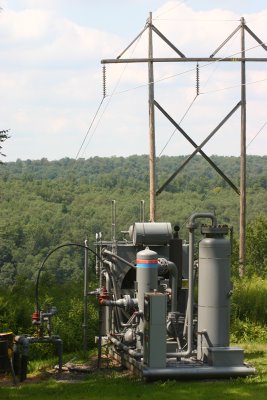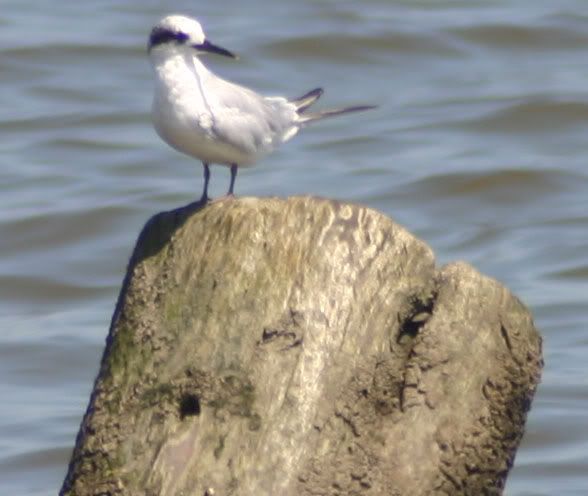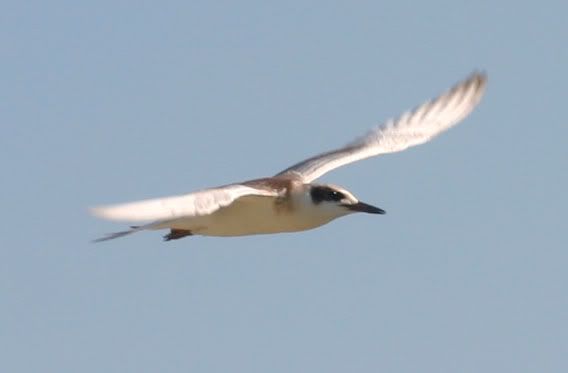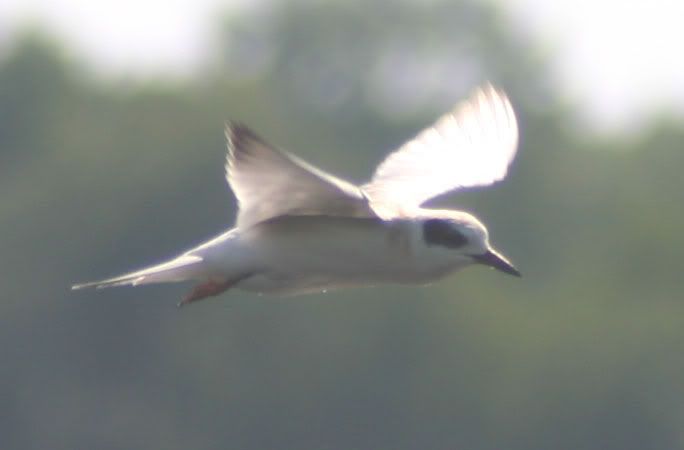Question about Overseas Birding
I was looking through some pictures of my 2004 study-abroad trip to Durban, South Africa when I came across a picture of what appear to be cormorants sitting on a rocky outcropping outside of Luderitz, Namibia.

For a larger version click
hereDuring my lunch break I checked with the excellent nature library available in my office and found Newman's Birds of Southern Africa Field Guide. Quickly I tracked the cormorants down to
Whitebreasted Cormorants found commonly on the Atlantic coast of Southern Africa.
This is pretty cool. I have no idea why I never thought back to the birds I saw in South Africa and Namibia while I was there...but the discovery of this photo brought a lot of birds back to my mind, birds that I had identified in the field. The question is, though, can I count these birds as part of my life list?
I'm not sure how this works. First, though, let me go over the list of birds that I definitely positively saw in Southern Africa (by the way, I really wish I had been into birding while I was there...I must have missed A LOT):
Ostrich: Kalahari National Park
Secretarybird: Umfolozi National Park
Sociable Weaver: Kalahari National Park
Jackass Penguin: Cape peninsula
Glossy Ibis: University of Kwa-Zulu Natal
Whitebreasted Cormorant: Luderitz, Namibia

Now, if I had put any effort in whatsoever I could have probably seen 100 times more birds than what are represented there, but those are the ones I definitely remember. I know I saw a flamingo in Luderitz, but I have no idea whether it was the greater or lesser so that's out. Then there was this awesome long-tailed bird that was always seen in the sugar fields outside Durban but there are a couple different possibilities so that's out. So, then, what is stopping me from adding these birds, anything?
Let's check the ABA (even though they apply to African birds) Recording Rules to see if including these birds would be any sort of ethical (moral!) violation:
A bird included in totals submitted for ABA lists must have been encountered in accordance with the following ABA Recording Rules.
(1) The bird must have been within the prescribed area and time-period when encountered.
(2) The bird must have been a species currently accepted by the ABA Checklist Committee for lists within its area, or by the A.O.U. Checklist for lists outside the ABA area and within the A.O.U. area, or by Clements for all other areas.
(3) The bird must have been alive, wild, and unrestrained when encountered.
(4) Diagnostic field-marks for the bird, sufficient to identify to species, must have been seen and/or heard and/or documented by the recorder at the time of the encounter.
(5) The bird must have been encountered under conditions that conform to the ABA Code of Birding Ethics.
OK so, again, these may be moot for African birds, but I think I qualify.
1. All the birds were in Namibia or South Africa, well within their normal range, when I saw them.
2. Well, there are very common, visible species in Africa and I'm sure they are accepted by African checklists.
3. Yes, yes and yes.
4. Yes I can remember them clearly and immediately knew in each case, except the cormorants which I can back up with a photo, which species they were.
5. I saw all these birds in non-invasive, ethical conditions.
Does that work for you? It works for me. I'm gonna include them.
If anyone reads this and can help clear things up, please leave a comment.
Birder Profile: Jeff Clark
Jeff Clark was one of the first people to respond to my listserv query about DC-area fall birding locations (I'm working on a post, I swear), and so he seemed a perfect candidate for my first birder profile in a couple months.
Since it's been awhile, here's a reminder that profiles are a bunch of questions that birders love to talk about given to a DC area-birder. The aim is to let everyone know a little bit more about those birding around them, and to maybe hear a good story or two.
Take it away, Jeff:
Name: Jeff Clark
DC Location: Fairfax City, VA
Profession: Software Architect
Years Birding: 4
Organizations: American Birding Association, Virginia Society of Ornithology, Cornell Lab of Ornithology, American Bird Conservancy
Lists: Life - 268; ABA – 267 (the Common Myna that I saw in the Burger King parking lot in Florida City, FL does not yet count towards my ABA list); VA – 178; Yard - 79
Field Guide: Sibley – Eastern though I own most all of the North American guides as well as a handful of guides to other parts of the world.
Optics: Stokes DLS 8x42 – Swarovski 65mm ATS HD Scope with zoom eyepiece
Favorite Bird: Rose-breasted Grosbeak – this is the bird that turned me from a passive bird-watcher into a birder. Seeing a gorgeous male come to my feeders one spring, dressed in his finest livery and bleeding a scarlet wash across his breast, sparked an obsession.
Least Favorite Bird (C’mon we’ve all got one): Blue-gray Gnatcatcher, only because they are so good at setting off my warbler alert: small bird flitting about high up in a tree.
Bird You’d Most Like to See but Haven’t: Gyrfalcon
Wish You Were Better at Identifying: Waterfowl. I need to do more winter birding!
Favorite DC-area birding location: Huntley Meadows
Favorite non-DC location: San Elijo and Batiquitos Lagoons, San Diego, CA
Best DC area Sighting: My best sighting, as far as rarity goes, was the White-faced Ibises at Huntley Meadows in the spring of 2006. That is the only “twitch” that I have ever done. My favorite sighting though is the first time I ever saw a Yellow-breasted Chat doing a display flight in the Woodcock meadow at Huntley Meadows.
Missed Opportunity: Shrimpy.
[Note: Shrimpy was the name of the Kelp Gull that was, until recently, found in Maryland. RIP ol' buddy.]Fondest Remembered Single Day: This past Spring (May of 2006 to be more precise) I played hooky from work and went to Monticello Park in Alexandria. I planned to stay 2 hours, max. Nearly 5 hours later I finally left. The first bird I saw upon walking in was a male Mourning Warbler perched in full view for at least 15 seconds! Breathtaking! As if this was not enough several absolutely stunning male Blackburnian Warblers put on a show. The real highlight though was a bird that I located myself and was the only report of from Monticello all spring. I heard a song that I only knew from bird song CDs, quick-three-beers. I quickly located a large flycatcher that was “wearing a vest” up on a dead tree, Olive-sided Flycatcher; a lifer for me and several others in the park that also got to see it. Totals for the ½ day were 15 warbler species and 42 total species. Besides the birds I met some wonderful birders. Days like that are what make Monticello legendary.
Speaking Out to Protect the Allegheny NF
On Tuesday evening I was up in Kane, PA attending and delivering comments at a public meeting on the future management of the Allegheny National Forest.  Every ten years (although its been 20 for the Allegheny), the U.S. Forest Service must take a look at its current management plan for a National Forest and decide whether or not it needs revision. For the Allegheny, the USFS created 4 potential plans and are currently taking public comments to help decide between them.
Every ten years (although its been 20 for the Allegheny), the U.S. Forest Service must take a look at its current management plan for a National Forest and decide whether or not it needs revision. For the Allegheny, the USFS created 4 potential plans and are currently taking public comments to help decide between them.
This is a very difficult decision for those living in and around the Allegheny NF. The local population has long been dependent on timber and oil & gas drilling in the NF for their income, but the most prosperous of these times seem to be behind them. Instead, people are beginning to hope that increased recreation and tourism in the forest will create a stable economy. The problem is, however, that so many years of logging and drilling have left a forest that may not be very exciting or wild...and I experienced that feeling firsthand.
When my coworker Craig Culp and I arrived in Kane we met Kirk Johnson from Friends of Allegheny Wilderness. Kirk agreed to show us around a bit and we drove out to an area called the Tionesta Research Natural Area, where a large section of old-growth forest still stands. On the way we passed a few of the over 9,000 active oil and gas wells in the forest (over 9,000! And that's not counting the 20,000 (!) decommissioned wells and nearly 1,000 new wells scheduled for the coming year). There was a little rig sitting right on the edge of the old-growth, and we could hear it humming loudly from hundreds of yards away, down near the stream.

I spoke as a representative of this website and discussed information on the birdlife in the forest. Here's what I said (very nervously...I haven't spoke in public, let alone a couple hundred strangers, since college):
(after introducing myself) I would like to share some information about birdlife in the Allegheny National Forest.
Throughout the year over 300 species of birds can be found in the Allegheny NF, including [I was making educated guesses here] 37 species of warbler, 16 raptors, 7 owls, 31 species of waterfowl and numerous species of sparrow, oriole, video, junco, chickadee, eagles, wading birds and blackbirds. Many of these birds, found commonly in the Allegheny, occur only rarely in other areas.
One of these species is the blackburnian warbler, a striking black and orange bird. Blackburnian warblers depend on thick, mixed-growth hardwood forests for their habitat. Ornithologists have found that the density of blackburnian warblers in the Tionesta old-growth forest, one of only two old-growth stands remaining in the forest, is more than 10x greater than their density in the surrounding, younger forest.
Another rare species is the cerulean warbler, one of the scarcest warblers in North America. One of America's largest populations of cerulean warblers lives in the northern section of the Allegheny NF and the adjacent Allegheny SP in New York.
The Allegheny NF also provides the southeasternmost border in the range of the Northern Goshawk, one of the scarcest birds of prey in America. The goshawk depends on dense, mixed-growth forests for its breeding and feeding.
Finally, the Allegheny Reservoir and Buzzard Swamp serve as important stopovers for waterfowl and passerines in the Atlantic flyway between the Great Lakes and the southern Atlantic coast.
These waterfowl, blackburnian warblers, cerulean warblers and northern goshawks are currently found reliably in the Allegheny, and they are birds that people will come to see. But only if their habitat is protected.
I support Plan Alternative D with the addition of the Citizen's Wilderness Proposal to provide for long-term security of these bird species.
It was short and sweet (I only took up about 2 of my allowed 5 minutes), but I think I got my point across: you won't get tourism unless you leave some areas protected.
On the whole the meeting went well, as locals with different viewpoints all spoke about their connections with the forest and what they thought the best way to manage it was. There seemed to be three groups represented: those affiliated with the logging industry who opposed any increase in wilderness protection, members of the snowmobile/atv community who support wilderness protection as well as increased recreational vehicle use, and, third, passionate environmentalists who support the maximum wilderness protection.

The Allegheny is very beautiful, but it needs a lot of protection and time to get back into a shape that people will want to visit. Click here for more information on the revision plans for the Allegheny National Forest, and contact Friends of Allegheny Wilderness to find out how you can support designating more wilderness areas in the forest.
Rare Birds in The Great State of Maine
I grew up in Falmouth, Maine and preach its gospel to whoever will listen. I love Maine so much that a year ago I got the state's outline tatooed on my arm (sorry, don't have a picture). Maine has it all: Ocean, woods, lakes and streams, nice little cities, hardworking villages, hicks and metropolitans, beaches and mountains. And, recently, some incredible birds.
A post yesterday (the 23rd) on the
Maine Birding List from
birdingonthe.net details a spotting on Maine's first ever
Burrowing Owl, which usually occurs in the American west and Florida. The bird is located on a piece of land that borders a military instillation and a private blueberry field (Maine's got the nation's best blueberries...) in the town of Columbia, up near Ellsworth in the DownEast area of the state. I'd estimate driving time from Portland to be about 2 hours and from the NH/ME border to be an hour longer (Mainers don't use MapQuest.)
If that wasn't enough, a
Western Reef Heron, whcih usually hangs out in India and Africa, was seen in the southern town of Kittery. The bird, dubbed
"The Bird of the Decade" by some local birders, was originally spotted in New Brunswick and has been working its way down the coast through Maine and into New Hampshire, where
these pictures were taken. Maybe it'll keep moving down to DC?
I and the Bird #30 and I
The 30th edition of the blog carnival
I and the Bird is now up at
Burning Silo. My post on birding the Bombay Hook NWR is included. Enjoy!
Loop Migrations
Are the same places I went to for the spring migration the same places I should go for the fall migration?
This question intrigues me more and more as I think about it. From a bird's perspective, a lot of these areas change a lot from spring to fall. Relying, as I have before, on the
excellent migration of birds site from the Northern Prairie Wildlife Research Center, I've dug up some information on birds that do not follow the same migration route in the fall as they do in the spring.
It's called a "loop migration." Check out the NPWRC page
here. Loop migrations have developed in a large number of unrelated species, from American Golden-Plovers to Connecticut Warblers, but scientists have not nailed down an exact cause or reason why one species would develop a loop and another would not.
There are a couple likely causes. Firstly, loop migrations could develop because, simply, the same route in the fall did not produce as much food for the birds as it did in the spring. Although reasons aren't given in the NPWRC article, I assume that birds that rely on food sources that change with the seasons (such as ripening berries or the horseshoe crab spawn) are more likely to develop loop migrations. What develops, then, is right from the pages of
The Origin of Species: birds who follow the spring path back down in the fall will not find enough food and either die, fail to reproduce or just not follow that same route the next year. Once all those birds are weeded out a loop migration has developed.
A version of this food hypothesis is used to explain the loop migration of the American Golden-Plover, which migrates up through the middle of the U.S. in the spring and down the east coast in the fall. Scientists think that the risk of still-frozen soil and foggy conditions in the spring force Plovers to take a safer route through the middle of the country. In the fall, though, late-ripening berries in Nova Scotia and the Maritimes provide the birds with the energy needed for the long migration.

Scientists provide another explanation for the loop migration developed by the Connecticut Warbler and several other small warblers. Radar observations have shown that wind directions are more favorable for an east coast fall migration, and the little birds need all the help they can get. Additionally, birds may be following more traditional paths based on their species' historical ranges.

Whatever the reason loop migrations develop for a species, most DC birders are very excited to see these birds come flocking back through our woods. So far the passerine migration has been pretty quiet while the shorebird migration is in full swing. Stay tuned in the next day or so as I compile a list of and directions to some of DC's most popular fall migration spots, with the help of members of the Va-Bird and MDOsprey listservs.
Teaming Up Against Arctic Drilling
John, the operator of DC's other excellent birding blog
A DC Birding Blog, has just now put up a post about
BP's shutdown of operations in Prudhoe Bay, Alaska.
This is a very important issue to me, and I want to expand on John's already excellent post. Here's what he had to say:
British Petroleum has shut down oil production at its fields at Prudhoe Bay, Alaska, because of leaks in its pipeline.
'BP, in a press release, said its engineers discovered a small leak and wall-thinning in a 22-mile long transit pipeline while conducting maintenance on August 4. It said analysis of data revealed 16 anomalies in 12 locations in the pipeline. BP is already facing a criminal investigation over a large spill in March at the same oil field.
BP said the spill, estimated at 4 to 5 barrels, had been contained and that a clean-up effort was underway. The pipeline was shut down at 6:30 a.m. Sunday morning.'
This oil field accounts for eight percent of the petroleum production in the United States.
It has to be embarrassing for BP, which has been running ad campaigns to make their products look environmentally-friendly for several years now.
This event and the spill in March should be a reminder of what can go wrong at an oil field. One of the claims proffered in favor of drilling in the Arctic National Wildlife Refuge is that the work would only affect a small portion of the refuge. What we see in these cases is that spills and accidents can end up having a wider impact than the one specified in the proposals. Petroleum production creates a heavy footprint. It is fortunate that this spill was small; it could have been worse.Great.
Just a couple things.
- The spill in March that John referred to was the spill of over 270,000 gallons of oil onto the frozen ground a couple hundred miles above the Arctic Circle. 270,000 gallons! It's in response to this event that the Department of Transportation demanded BP test their pipelines, the first time the company did so since 1992. Here's what that looks like:

- Aside from the recent '4 to 5 barrel' spill and the massive March spill, there have been thousands of other spills in Alaska. In fact, the Alaska Department of Environmental Conservation reports 4,532 spills in Alaska from 1996 to 2004 totaling more than 1.9 million gallons of toxic substances poured onto the ground.
- When the drilling companies say that their activities will only take up a small portion of an area, like the Arctic National Wildlife Refuge, they are being misleading. They'll use terms like "postage stamp" to make it seem like the wells will occupy just a small, square corner of the total land. In reality, the drill pads take up a small area but the pipelines and roads stretch all over like a spider web. Think of it this way, although each strand of a spider web is very thin, the whole web takes up a much larger area. That's what happens to an area when oil companies move in. It looks like this:

Go here for a slightly better look.
Drilling is not the answer anymore. America has long led the way in the innovation of new technologies, and it's time for us to put our heads together and open a can of elbow grease and find a solution that doesn't involve non-renewable resources and environmental destruction. Come on, USA, we can do better than this.
Finally, Some Birds
On Saturday Kate and I decided we needed a break from this sweltering city and decided to take a spur-of-the-moment trip to Delaware. We threw some stuff in a backpack, rushed out the door and in no time at all were...stuck in traffic on the way to the bay bridge.
I guess we should have expected that on the first bearable Saturday in the summer that every single vehicle in the DC area would be headed to the beach, but we left in such a skipping rush that the thought hadn't crossed our minds until we were crawling along Route 50 and playing the Beatles-Zeppelin Game until our fingers hurt (Kate and I have a bet about which band gets played on the radio - all stations, not just classic rock - more often, the Beatles or Led Zeppelin. I say the Beatles based on the size of their catalogue and the fact that they can be played on more stations. Kate says Zep because, well, they're always a reliable bet on classic rock stations. Overall the race is neck and neck, but on this trip the Beatles completely triumphed: 5 songs, 2 covers (which don't count, but still) and one NPR story about the 40th anniversary of Revolver. Zeppelin: 0).

Anyway, after lots of traffic and several outbursts of rage from me (I hate traffic), we finally found ourselves on the lovely coast of Delaware. We were looking for Bombay Hook NWR, where the shorebird migration was apparently in full swing and there had been recent sightings of a curlew sandpiper and reeve, among other sweet birds. But we were lost (in our rush to leave we didn't bother with directions)...and while driving around aimlessly we happened upon a spot I had birded earlier this year: Port Mahon Road.
Port Mahon Road was obviously good in spring (check out my post from the
2006 Horseshoe Crab migration), but I had no idea whether there would be anyone there in August. Well, there was, albeit in much lesser numbers. Ruddy Turnstones gathered in groups at the shoreline and a few peeps could be seen darting along the sand. Most interesting to me, though, were all the terns. I haven't had a whole lot of tern experience in my birding life (let's see: black, common, Foresters, Caspian in Anacostia earlier this year and a least tern in Maine a month ago...) and I was excited to take a look at some up close.
Every pile-on at the waterside had a tern on it. Most of the birds were already in their non-breeding plumage, but tern identification is relatively easy thanks to different bill and feet color combinations. I got good looks at common terns, Foresters terns and...whatdya know...lifer sandwich and royal terns. Here's a shot of a sandwich, the ID here being the black bill with a light tip, black feet and the lack of a dark carpal bar on the shoulder:

So, two life birds right off the bat, and unexpectedly. Let's head off to Bombay Hook.
I love the place. Beautiful, spacious and, most importantly for a city guy, absolutely quiet. One of my top 3 birding locations, easily, and a place I enjoy
in the winter as well.
And always with great birds. As I rolled up to the entrance I was greeted with a telephone-wire full of barn and bank swallows, the latter of which I hadn't seen since Point Pelee over a year ago. Before I left I would see enough bank swallows to last be well into next year...

The ponds were dry and filled (filled!) with shorebirds. I don't own a scope and the backlight made IDs on distant birds nearly impossible (and very frustrating), but I could see both yellowlegs, semipalm sandpipers, semipalm plovers, willet, both dowitchers, great and snowy egrets, great blue herons and more terns. Kate and I motored through to Bear Swamp, where the best of the day's birds had been reported (gull-billed tern, tricolored heron, little blue heron and black terns). Thankfully, a group of birders allowed me to use their scope and they helped point out several lifers for me.
I had never had the patience to ID least sandpipers and long-billed dowitchers before, but now I saw them. I also saw a beautiful (and surprisingly small) tricolored heron out in the marsh alongside a great egret. Finally, my year immature black tern was swooping and diving right off the road.
Despite several fake-outs, I never saw the gull-billed tern, a Delaware specialty. I took a few pictures, though, and I can still talk myself into thinking that this guy is the gull-billed (damn you red feet!):

It's a Foresters tern.
So: 5 life birds bringing my 1.5 year total to 234. 7 year birds bringing that total to 194, just 5 away from my year total last year. A whole bunch of DE birds and 4 traffic jams. A great break from the city, some crabs on the eastern shore on the way back, and Kate along for the ride added up to a wonderful day.
Next weekend I'll be headed up to central NY to visit some friends and maybe to take a crack at that red crossbill in the New Michigan SF...















